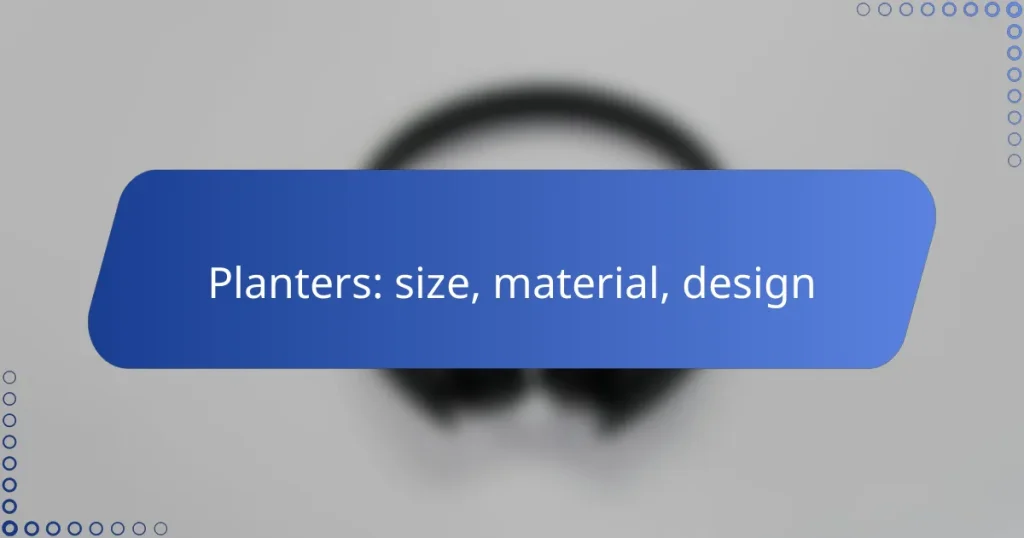When selecting planters, it’s essential to consider size, material, and design to ensure optimal plant health. The right size provides adequate root space and drainage, while materials like plastic, ceramic, wood, and metal each offer unique benefits and styles. Additionally, thoughtful design can enhance moisture retention and temperature regulation, further supporting plant growth.
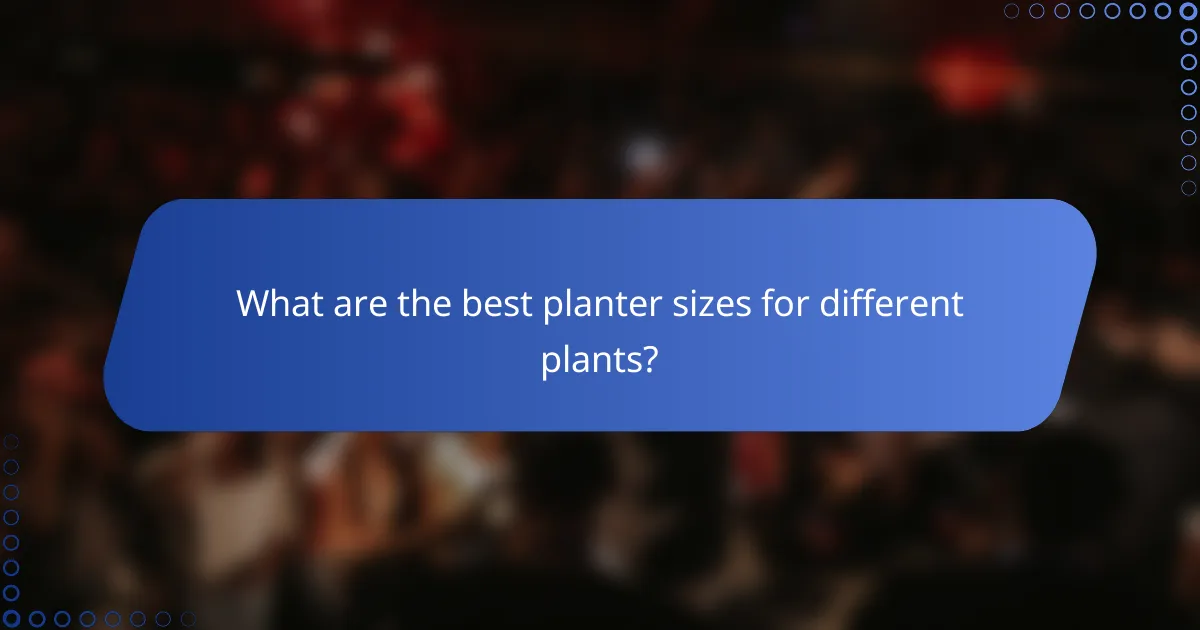
What are the best planter sizes for different plants?
The best planter sizes vary depending on the type of plants you are growing. Choosing the right size ensures adequate root space, proper drainage, and overall plant health.
Small planters for herbs
Small planters, typically ranging from 4 to 8 inches in diameter, are ideal for growing herbs like basil, parsley, and cilantro. These compact sizes allow for easy placement on windowsills or small patios.
When selecting small planters, ensure they have drainage holes to prevent waterlogging. Consider using lightweight materials like plastic or terracotta for ease of movement.
Medium planters for flowers
Medium planters, usually between 10 to 14 inches in diameter, are suitable for a variety of flowering plants such as petunias, marigolds, and geraniums. This size provides enough space for roots to expand while still being manageable.
Opt for materials like ceramic or fiberglass for durability and aesthetic appeal. Ensure your medium planter has sufficient drainage to keep flowers healthy and vibrant.
Large planters for shrubs
Large planters, ranging from 16 to 24 inches in diameter, are perfect for shrubs like boxwood or hydrangeas. These planters accommodate deeper root systems and require more soil to retain moisture.
When choosing large planters, consider their weight and stability, especially if placed in windy areas. Materials such as concrete or heavy-duty plastic can provide the necessary support.
Extra-large planters for trees
Extra-large planters, typically 30 inches in diameter or more, are essential for growing small trees or large shrubs. They offer ample space for extensive root systems and help maintain moisture levels.
These planters often require a sturdy base, so consider using materials like stone or reinforced plastic. Ensure proper drainage and consider using a mix of soil designed for trees to promote healthy growth.
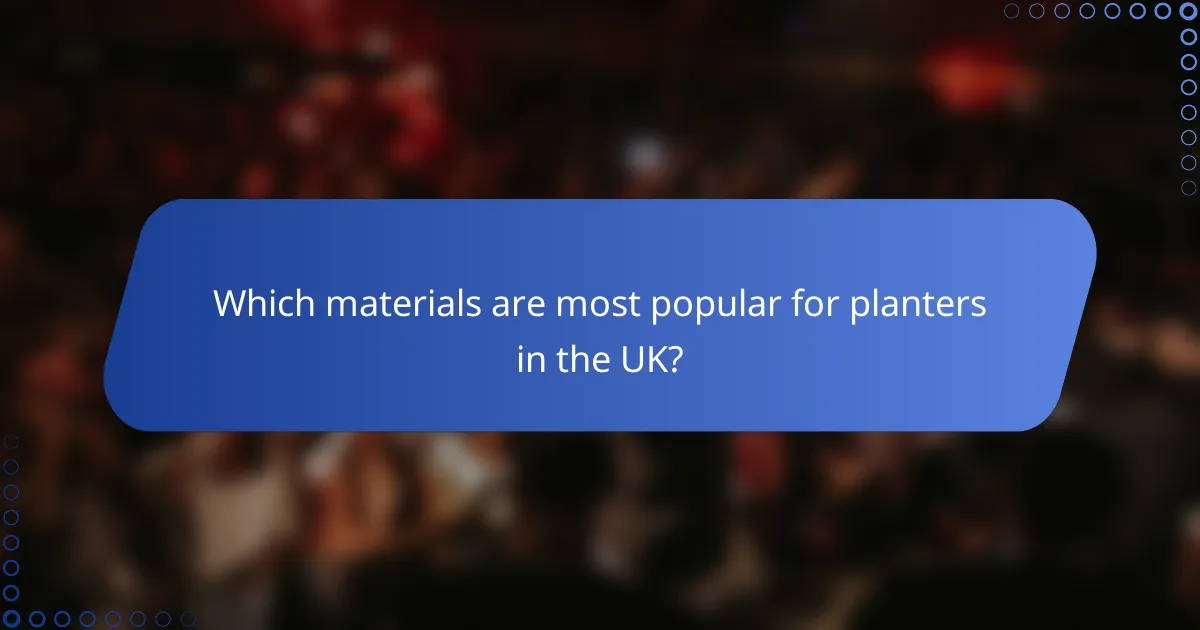
Which materials are most popular for planters in the UK?
In the UK, the most popular materials for planters include plastic, ceramic, wood, and metal. Each material offers distinct advantages and aesthetic qualities, making them suitable for various gardening styles and environments.
Plastic planters for lightweight options
Plastic planters are favored for their lightweight nature, making them easy to move and rearrange. They are often available in a wide range of colors and sizes, allowing for versatile design choices.
When selecting plastic planters, consider those with UV protection to prevent fading and cracking from sunlight exposure. They are generally more affordable, often costing between £5 and £30 depending on size and design.
Ceramic planters for aesthetics
Ceramic planters are known for their beauty and come in various glazes and finishes, adding an elegant touch to any space. They are ideal for decorative purposes and can enhance the visual appeal of indoor and outdoor settings.
However, ceramic planters can be heavier and more fragile than other materials, so it’s important to handle them with care. Prices typically range from £10 to £100, depending on craftsmanship and design intricacies.
Wooden planters for durability
Wooden planters are appreciated for their natural look and durability. They can withstand outdoor conditions well, especially if treated with weather-resistant finishes, making them suitable for gardens and patios.
When choosing wooden planters, opt for rot-resistant woods like cedar or redwood to ensure longevity. Prices can vary widely, starting from around £20 for smaller options to several hundred pounds for larger, custom designs.
Metal planters for modern designs
Metal planters offer a sleek, contemporary aesthetic that complements modern landscaping. They are often made from materials like galvanized steel or aluminum, which provide strength and resistance to rust.
Consider the thermal properties of metal, as they can heat up quickly in direct sunlight, potentially affecting plant roots. Prices for metal planters generally range from £15 to £150, depending on size and finish.
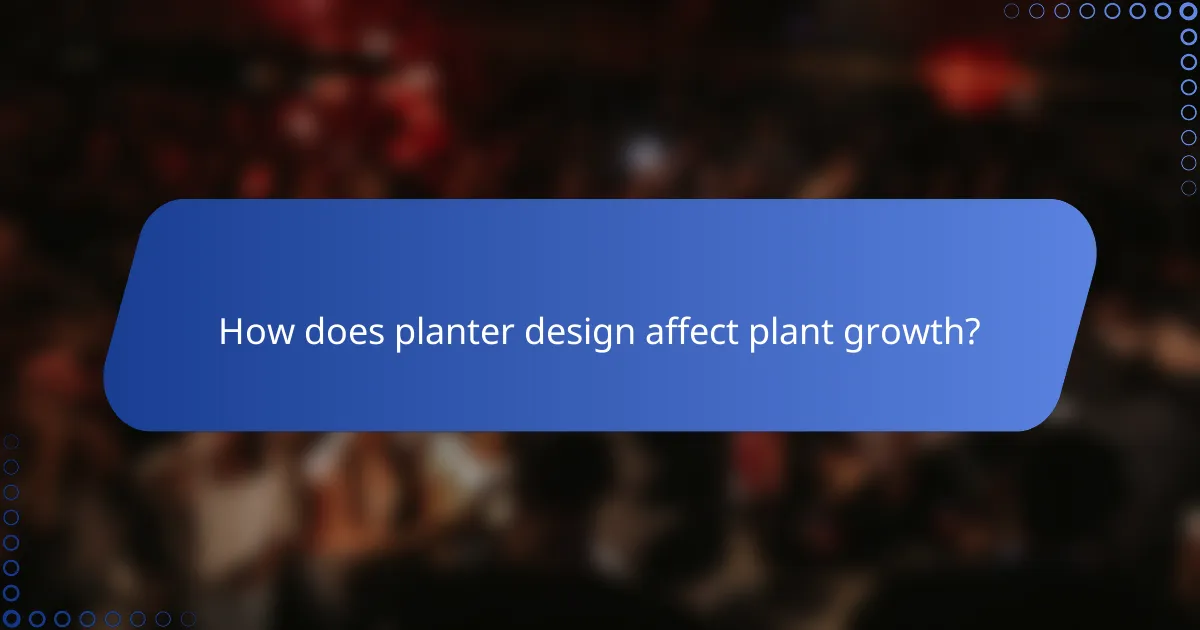
How does planter design affect plant growth?
Planter design significantly influences plant growth by impacting factors such as moisture retention, root development, and temperature regulation. Choosing the right design can enhance plant health and optimize growth conditions.
Drainage holes for moisture control
Drainage holes are crucial for preventing water accumulation, which can lead to root rot. A well-designed planter should have adequate drainage to allow excess water to escape while retaining enough moisture for the plants.
When selecting a planter, look for those with multiple drainage holes, especially for plants that prefer drier conditions. If you’re using a pot without drainage, consider adding a layer of gravel at the bottom to help with moisture control.
Shape influences root development
The shape of a planter can affect how roots spread and access nutrients. Deep, narrow pots are suitable for plants with long root systems, while wide, shallow containers work better for plants with spreading roots.
When choosing a planter, consider the mature size of the plant’s root system. For example, a tomato plant may thrive in a deeper pot, while herbs like basil can do well in shallower containers.
Color affects heat absorption
The color of a planter can influence its temperature, which in turn affects plant growth. Dark-colored pots absorb more heat, making them suitable for warmer climates, while light-colored pots reflect sunlight and keep roots cooler.
In cooler regions, opt for darker planters to help retain warmth for heat-loving plants. Conversely, in hotter areas, light-colored containers can help prevent overheating and protect sensitive roots.
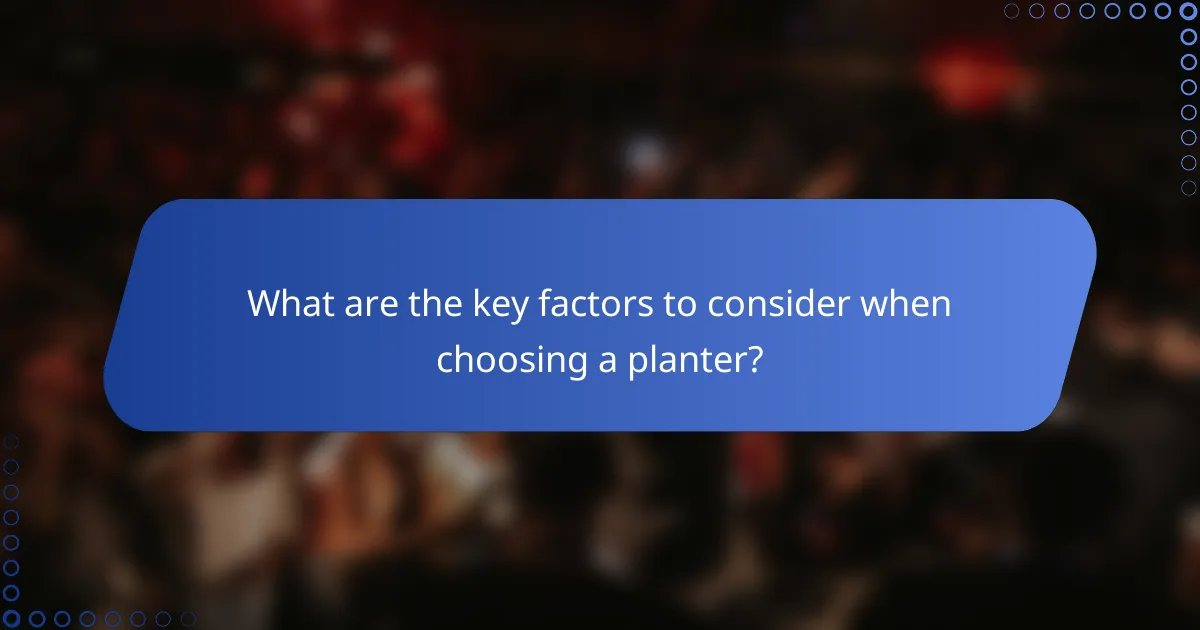
What are the key factors to consider when choosing a planter?
When selecting a planter, consider size, material, and design to ensure it meets the needs of your plants and complements your living space. Each factor plays a crucial role in plant health and aesthetic appeal.
Size relative to plant type
The size of the planter should match the growth requirements of the plant. Generally, larger plants need bigger pots to accommodate their root systems, while smaller plants can thrive in compact containers. A good rule of thumb is to choose a planter that is at least 1-2 inches wider in diameter than the plant’s root ball.
For example, a small herb like basil can flourish in a 6-8 inch pot, while a medium-sized shrub may require a pot that is 12-16 inches in diameter. Always consider the mature size of the plant to avoid frequent repotting.
Material suitability for climate
The material of the planter affects its durability and the plant’s health, especially in varying climates. Common materials include plastic, ceramic, wood, and metal, each with its pros and cons. For instance, ceramic pots retain moisture well but can crack in freezing temperatures, while plastic is lightweight and resistant to breakage but may not provide adequate insulation.
In hot climates, consider using materials that allow for good drainage and airflow, such as terracotta, which helps prevent root rot. Conversely, in cooler regions, insulated materials can help protect roots from extreme cold.
Design compatibility with home decor
The design of the planter should harmonize with your home decor style. Whether your space is modern, rustic, or traditional, choose planters that enhance the overall aesthetic. For example, sleek, minimalist planters work well in contemporary settings, while ornate, colorful pots may suit a more eclectic style.
Additionally, consider the color and texture of the planter. Neutral tones can blend seamlessly into any decor, while bold colors can serve as statement pieces. Always ensure that the planter’s design complements the plants it holds, creating a cohesive look.
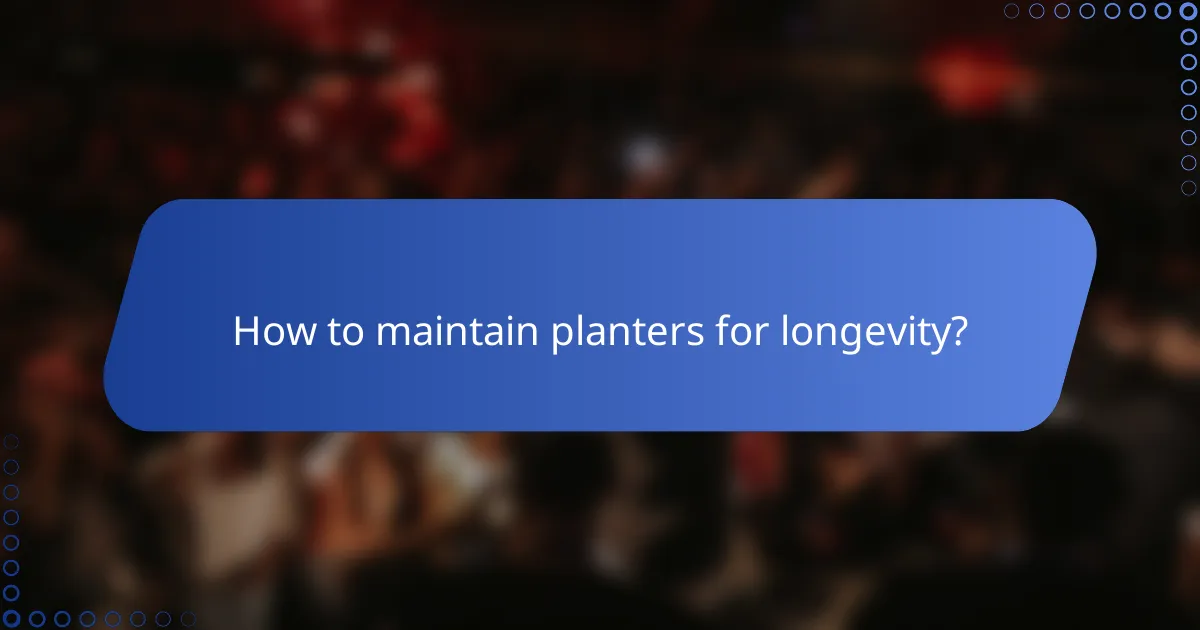
How to maintain planters for longevity?
To ensure planters last for many seasons, regular maintenance is essential. This includes cleaning, inspecting for damage, and storing them properly during colder months.
Regular cleaning to prevent algae
Cleaning planters regularly helps prevent algae buildup, which can harm plants and create an unattractive appearance. Use a mixture of water and mild soap to scrub the surfaces, focusing on any areas that retain moisture.
Rinse thoroughly to remove all soap residue, as leftover chemicals can affect soil and plant health. Aim to clean your planters at least once a month during the growing season.
Seasonal checks for damage
Conduct seasonal inspections of your planters to identify any cracks or wear that may have developed. Look for signs of deterioration, especially after extreme weather conditions, which can weaken materials.
Repair minor damages promptly to prevent further issues. For example, use waterproof sealants for cracks in ceramic or concrete planters to extend their lifespan.
Proper storage during winter
When winter approaches, it’s crucial to store planters properly to avoid damage from freezing temperatures. If possible, move them indoors or to a sheltered area to protect them from harsh weather.
For larger planters that cannot be moved, empty the soil and ensure they are clean and dry. This prevents cracking from ice expansion and keeps them in good condition for the next planting season.
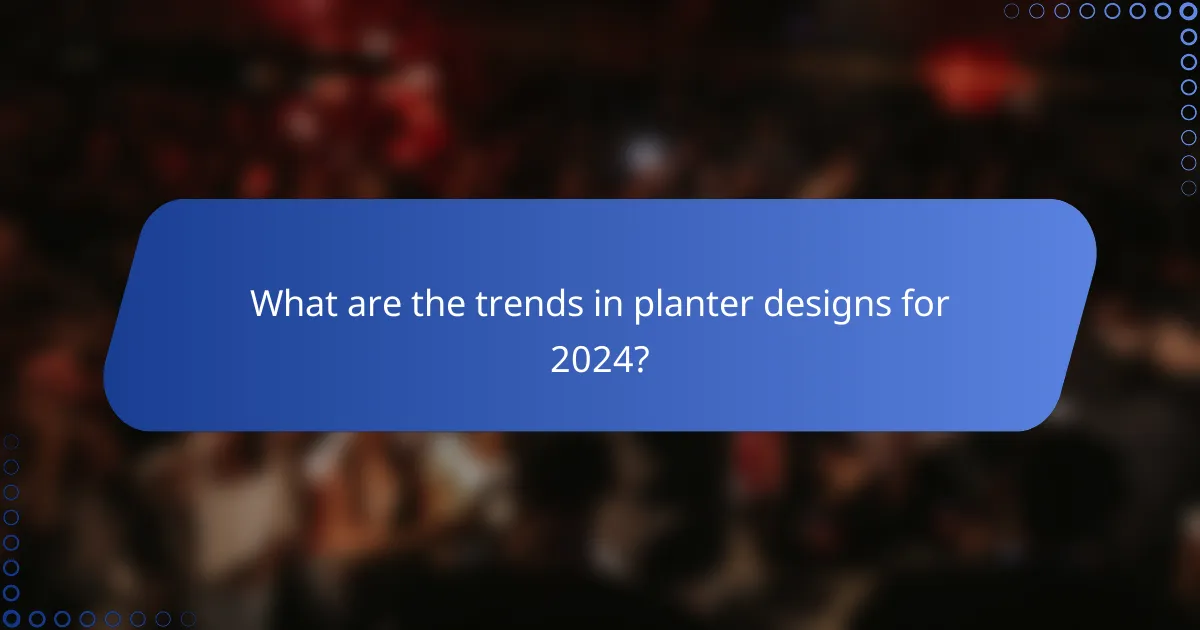
What are the trends in planter designs for 2024?
In 2024, planter designs are focusing on sustainability, versatility, and aesthetic appeal. Key trends include eco-friendly materials, modular designs, and vibrant colors that enhance outdoor and indoor spaces.
Size considerations for planters
When selecting planter sizes, consider the type of plants and their growth potential. Planters should be large enough to accommodate root systems while allowing for proper drainage. For small indoor plants, pots ranging from 15 to 30 cm in diameter are common, while larger outdoor planters can exceed 60 cm.
Additionally, think about the space available. For balconies or small patios, compact planters or vertical gardens are ideal. In contrast, spacious gardens can benefit from larger, statement planters that serve as focal points.
Material choices for planters
Planters are available in various materials, including ceramic, plastic, wood, and metal, each offering unique benefits. Ceramic and terracotta provide excellent insulation for roots but can be heavy and fragile. Plastic is lightweight and durable, making it suitable for all weather conditions.
Wooden planters add a natural aesthetic but require treatment to prevent rot. Metal planters can be stylish but may heat up quickly in direct sunlight, affecting plant health. Choose materials based on durability, weight, and the specific needs of your plants.
Design styles for planters
In 2024, design styles for planters are embracing minimalism, geometric shapes, and bold colors. Minimalist designs often feature clean lines and neutral tones, making them versatile for various settings. Geometric planters add a modern touch and can create visual interest.
Bold colors and patterns are also trending, allowing planters to serve as decorative elements in gardens or interiors. Consider how the design complements your overall decor and the plants you intend to use, ensuring a harmonious look.
